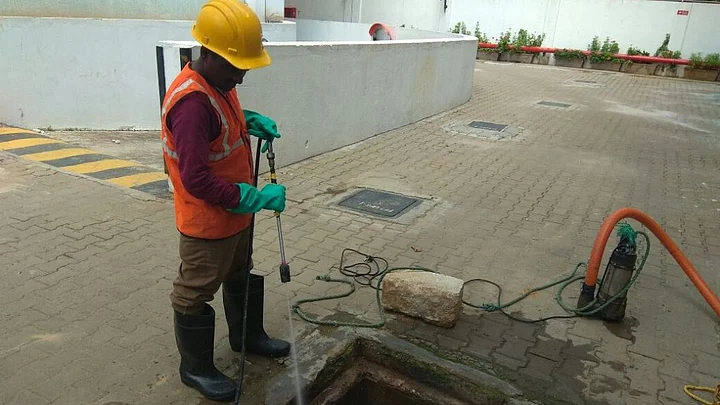Three workers choked to death while clearing a clogged sewage treatment plant (STP) at an apartment complex in Bengaluru on 9 January 2017. Their bodies were found in the 20-foot-deep plant an hour later.
These labourers lost their lives after inhaling the toxic air within the STP at ND Sepal Apartment in HSR Layout. But did they really have to die? There are now machines available to clean the STPs without putting anyone in danger.
What this tragic incident shows is that apartments in the city continue to resort to the practice of manual scavenging despite it being forbidden by law, and despite the development of jetting and suction machines that are known to effectively do the same job.
These mechanical devices trap and absorb debris, muck and other unwanted sediments from sewage plants.
However, many flats and residential colonies across Bengaluru have been shying away from adopting the new method. What causes this reluctance?
1. Lack of Awareness Among Residents
There are quite a few residential areas that continue with the inhumane method of employing manual labour to remove blockages. Lack of awareness among these residential colonies seems to be a matter of grave concern.
Since we do not know of any other alternative method to get the sewage lines cleaned, we avail the services of certain labourers every six months to get it done.Suma Murthy, Member of Resident Welfare Association, Girinagar
Several RWAs across the city like Mahalakshmi Layout, Michaelpalya near Indiranagar and New Byappanahalli, said that they were unsure about how sewage lines and tanks are cleaned in their own areas.
Shubha Ramachandra, who works as a Water Sustainability Consultant with Biome, a Bengaluru-based design firm that focuses on ecology, architecture and water, agrees that there is a lack of awareness among RWAs and management committees across the city when it comes to availing of professional services for these tasks.
Residents don’t even know that machines can be used to clean their sewage lines and septic tanks. They do not know any specifics of how to choose the right service provider. Sadly, even the civic authorities have not made an effort in promoting awareness.Shubha Ramachandra, Water Sustainability Consultant, Biome
2. Use of Jetting & Suction Machinery Is a Pricey Affair
The contaminants and slurry in STPs needs to be removed periodically so as to make it suitable for disposal or application to land. Jetting and suction machinery are effective in clearing the blockages as well as extracting solids and grease.
Professional service providers make use of such machinery to clean and maintain STPs, making them an expensive exercise.
We charge anywhere between Rs 30,000 to 50,000 per month to clean and maintain the sewage plants at apartments depending on the capacity of the tank. The average capacity is in the range of 4,000 to 6,000 litres.Shashidhar, Proprietor, Maruthi Enterprises
Most of these service providers enter into Annual Maintenance Contracts (AMC) with apartments. Nevertheless, they also provide one-time cleaning services, in which case, the price is lower. “Apartments and residential colonies form a very small part of our client base. We so far have only 50 permanent customers,” Shashidhar added.
The cost involved in hiring private service providers acts as a deterrent for many apartments in the city. They find it to be an expensive affair and therefore employ other cheaper alternative methods to clean the sewage, even manual labour for that matter. “Hiring professional to clean STPs doesn’t work well with several of the smaller apartments due to the sheer amount of money they need to shell out,” said Dr Ananth S Kodaivasal, Director of consulting firm Eco-tech Engineering.
3. Lack of Clarity About the Number of Professional Service Providers
Though Bengaluru has installed one of the highest numbers of STPs in the country, there is no clarity on the total number of service providers who cater to its cleaning and maintenance.
Though the Karnataka State Pollution Control Board (KSPCB) has published a set of guidelines and specifications with regard to the operation and design of sewage plants, there is no official record of the vendors or private service providers.Shubha Ramachandra, Water Sustainability Consultant, Biome
The officials at the KSPCB were not available to comment on the issue. Hence, the lack of readily available information about the firms who engage in mechanised cleaning of sewage plants is a major deterrent. Neither the civic authorities nor the service providers seem to be taking a keen interest in promoting these services. V Satish, President of Resident Welfare Association, Brigade Gateway, said:
We have signed a contract with a Chennai-based service provider since we were unable figure out if the same kind of professional maintenance was available in Bengaluru.
(At The Quint, we question everything. Play an active role in shaping our journalism by becoming a member today.)
